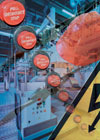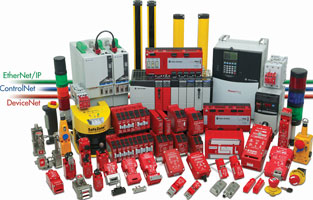

Refined safety legislation and new developments in technology have opened up a tantalising possibility in safety network implementation – the ability to put safety control devices alongside standard control devices on the same wire or network.
Dr Richard Piggin, of Rockwell Automation, who is a UK expert and ODVA liaison to IEC working group SC65C/WG12, currently developing IEC 61784-3: Functional Safe Communication, describes the paradigm of truly integrated safety.
It seems only yesterday that we were talking about how the move from hard-wired systems to network architectures represented a fundamental change in machinery safety. But such has been the take-up of the so-called safety network that it is easy to forget how recently the change in machinery safety legislation - and in particular the introduction of IEC 61508 - made it all possible. So the challenge now is not to implement a safety network, but rather to integrate that crucial aspect into the overall network architecture.
IEC 61508 redefined the way safety systems are assessed - switching from a prescriptive, rules-based approach to a goal-based approach. This enabled manufacturers to move away from hard-wired safety systems, and to take advantage of safety controls and networks. The sense of déjà vu was palpable, echoing the moves two decades ago, within the standard control environment, from relays to PLCs and from parallel wiring to fieldbus.
And the benefits have been the same. Installation times (and therefore costs) can be dramatically reduced, while the overall flexibility of the safety system to accommodate change is increased. Improved diagnostics, ease of testing and modularity all make the safety net easy to maintain, so helping to reduce downtime. More sophisticated systems become easier to understand and implement.
Rockwell Automation delivers an integrated architecture that seamlessly harmonises all the control disciplines, including safety, into a single solution architecture with common tools and training that speeds up deployment and lowers overall cost of ownership. From simple relays and sensors to fully integrated control systems, Rockwell Automation offers the tools and expertise to assist manufacturers shape safety solutions to support both manufacturing and safety goals.

Safety networks have evolved very quickly. In early implementations, the safety network was kept completely separate from the standard control network. Indeed, there are some companies today which still insist that this strategy is the only way to guarantee functional safety. But the need to run a separate, quite distinct and often unrelated safety network alongside the standard control network, has distinct disadvantages. In particular, installing and supporting two completely different network architectures is far from ideal. A better approach is to implement the safety network as an actual extension of the standard control network, with safety devices and standard control devices connected on the same wire.
The latest technological developments mean that such a strategy is a reality, without compromising on stringent safety standards. In particular, there is the possibility of implementing safety networks as extensions to open fieldbus networks such as DeviceNet and EtherNet/IP.
How might this be possible? The key lies with the Common Industrial Protocol (CIP) - the open, common application layer shared by DeviceNet and EtherNet/IP, as well as other CIP networks including ControlNet. In 2005, the CIP Safety Specification was published, providing functional safety extensions and extending the application coverage for CIP to include integrated safety communications in accordance with IEC 61508 SIL 3 and EN 954-1 Category 4.
The first practical implementation of CIP Safety was on DeviceNet, bringing all the benefits of improved diagnostics and ease of commissioning that users have long enjoyed with standard DeviceNet. The result, DeviceNet Safety, not only looked and felt like standard DeviceNet, it offered the possibility for true integration with standard DeviceNet, allowing users to connect safety devices and standard control devices on the same wire or network, either with or without a dedicated safety PLC or controller. More recently the CIP Safety on EtherNet/IP, the prevalent industrial Ethernet specification, was announced. This offers a simple means of integrating safety networks into exactly the same Ethernet architecture as used by standard control devices, the rest of the enterprise and even the Internet.
Rockwell Automation has a full suite of products available for DeviceNet Safety, including safety input/output blocks, safety interlock switches, safety light curtains, safety drives and safety PLCs, and the company is steadily introducing a similar portfolio of products and solutions for EtherNet/IP Safety.
Overall, the benefits for manufacturers in moving to truly integrated safety solutions are enormous. Hardware costs are minimised, since components can be used by both the standard and safety portions of the system. Manufacturers can also reduce their software and support costs - the same software can be used throughout the plant, and operators only have to learn one architecture. Scalability is easy, since the integrated system continues to evolve, as needs demand, with the addition of new safety components or entire new network segments. Depending upon system requirements, engineers can deploy and distribute the necessary hardware to meet the application demands, whether on an individual machine or within an entire facility.
Applying the wide range of component and system-based safety solutions from Rockwell Automation allows manufacturers to integrate existing controls with safety systems which lowers total cost of ownership. The result can be a more productive, more profitable plant with a safety automation system that can quickly adapt to the rapidly changing demands of manufacturing.
For more information contact Jeff Sandison, Rockwell Automation, +27 (0)11 654 9700, [email protected], www.rockwellautomation.co.za
| Tel: | +27 11 998 1000 |
| Email: | [email protected] |
| www: | www.rockwellautomation.co.za |
| Articles: | More information and articles about Rockwell Automation |

© Technews Publishing (Pty) Ltd | All Rights Reserved